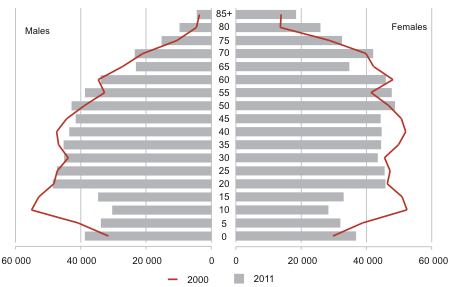1,294,236 permanent residents of Estonia were enumerated in the census
During the 2011 Population and Housing Census, conducted from 31 December 2011 until 31 March 2012, 1,294,236 permanent residents of Estonia were enumerated, including 693,884 women and 600,352 men. 68.7% of the enumerated permanent residents defined themselves as Estonians and 24.8% as Russians. 4.9% of the enumerated permanent residents specified another ethnic nationality and 1.5% did not specify any ethnic nationality.
Compared to the previous Population and Housing Census in 2000, the number of permanent residents has declined by 75,816 (in 2000, 1,370,052 permanent residents were enumerated). According to the international definition, a permanent resident is a person who has lived in the country for at least a year before the census moment (31 December 2012) or intends to live in the country for at least a year.
The age structure of the population has changed since the previous census. “The preliminary results of the census confirm that the population trends that emerged after the restoration of independence have continued in Estonia,” said Professor Ene-Margit Tiit, the Head of Methodology of the 2011 Population and Housing Census (PHC 2011).
In 2000, the proportion of children (aged 0–14) in the population was 18%, whereas by 2011 their proportion had decreased to 15%. At the same time, the proportion of people aged 65 and over had increased to 18% (compared to 15% in 2000). The share of the working-age population (aged 15–65) had remained on the same level as in 2000 (67%).
Population age-pyramid
Enumerated permanent residents by counties
"The regional concentration of the population has continued," said Professor Tiit. Compared to the previous census, the populations of Harju and Tartu counties have increased and the populations of the other counties have decreased. The population numbers of local governments will be published at the end of 2012.
| 2000 | 2011 | change | change, % | |
|---|---|---|---|---|
| HARJU COUNTY | 525 682 | 552 643 | 26 961 | 5.13 |
| of which Tallinn | 400 378 | 392 331 | -8 047 | -2.01 |
| HIIU COUNTY | 10 440 | 8 470 | -1 970 | -18.87 |
| IDA-VIRU COUNTY | 179 702 | 149 244 | -30 458 | -16.95 |
| JGEVA COUNTY | 38 297 | 31 398 | -6 899 | -18.01 |
| JRVA COUNTY | 38 781 | 30 553 | -8 228 | -21.22 |
| LNE COUNTY | 28 644 | 24 184 | -4 460 | -15.57 |
| LNE-VIRU COUNTY | 67 801 | 59 861 | -7 940 | -11.71 |
| PLVA COUNTY | 32 695 | 27 452 | -5 243 | -16.04 |
| PRNU COUNTY | 91 212 | 82 584 | -8 628 | -9.46 |
| RAPLA COUNTY | 37 593 | 34 905 | -2 688 | -7.15 |
| SAARE COUNTY | 35 951 | 31 344 | -4 607 | -12.81 |
| TARTU COUNTY | 149 602 | 150 287 | 685 | 0.46 |
| VALGA COUNTY | 35 796 | 30 158 | -5 638 | -15.75 |
| VILJANDI COUNTY | 57 974 | 47 594 | -10 380 | -17.90 |
| VRU COUNTY | 39 882 | 33 439 | -6 443 | -16.16 |
* The data are based on the county borders at the time of the census.
The preliminary results of the census are published in Statistics Estonia’s database.
By December 2012 the latest, the preliminary results of the Population and Housing Census will undergo a further comparison with different state registers. This allows Statistics Estonia to assess the number of persons who were not enumerated (under-coverage). After that it will be possible to decide whether any revisions are needed in the population statistics.
The results of PHC 2011 will be published over 2012 and 2013. The preliminary schedule can be found at www.stat.ee/54615.
The 11th population census in Estonia was conducted from 31 December 2011 until 31 March 2012. Previous censuses were carried out in 1881, 1897, 1922, 1934, 1941, 1959, 1970, 1979, 1989 and 2000. The next population census will be conducted in Estonia in 2020/2021.
